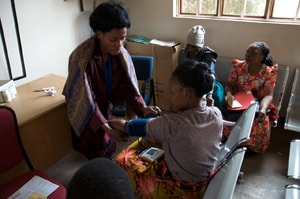Integrating HIV and hypertension management to improve lives in Malawi

Screening patients for hypertension at a clinic in Malawi.
Photo credit: Victor Balaban.
By 2020, noncommunicable diseases (NCDs) are predicted to account for 65 percent of deaths in Africa. Increasing rates of NCDs in sub-Saharan Africa are threatening the progress made by the global health community to combat infectious diseases such as HIV and tuberculosis (TB). To address this issue, the US Centers for Disease Control and Prevention (CDC) and national partners are pioneering the integration of public health programs that address risk factors for NCDs along with existing efforts to fight HIV and TB. In Malawi, this coordinated approach not only addresses the increased risk of NCDs among people living with HIV (PLHIV), but also stretches every public health dollar to ensure that programs are having the greatest impact within communities.
Malawi: A perfect storm
The landlocked country of Malawi, which is among the smallest countries in Africa, has one of the highest HIV prevalence rates in the world (10.3 percent of the population). It is also estimated that 33 percent of Malawians aged 25-64 years old have high blood pressure, which is a leading risk factor for cardiovascular diseases including heart attack and stroke. The President’s Emergency Plan for AIDS ReliefExternal
“One-stop-shop” for hypertension and HIV
Working alongside Malawi’s Ministry of HealthExternal
The blood pressure screening and management pilot project was introduced in two Lighthouse clinics in February 2015. To avoid disrupting clinic activities and ensure a manageable workload, the project gradually added different age groups of patients (>20-60+ years old) to the blood pressure screening program. The clinics started using a standardized electronic protocol for hypertension treatment among persons living with HIV (PLHIV). The protocol gives clinicians consistent guidance on how to prescribe medications for both HIV and hypertension to avoid side-effects and improve clinical outcomes of both diseases.
Baobab Health Trust took the project to the next level by adding a hypertension section to the existing electronic medical record system (EMRS). This helped medical staff make more informed medical decisions, and may allow the program to expand to other Malawi clinics in the future because the module is compatible with the national EMRS.
In just 18 months, the program has given blood pressure screenings to over 29,000 people in two clinics. More women (17,565) were screened than men (11,794), but hypertension prevalence was higher among men (16%) than women (9%). Eleven percent of those screened were newly diagnosed with hypertension and 85% of those with hypertension received treatment following the protocol guidelines. The total cost of hypertension treatment per person was less than five US dollars per year. Despite the project’s success integrating hypertension screening and management into routine HIV service delivery, expansion is challenging because of difficulties getting proper medications.
Spreading solutions
As a result of this project, Malawi’s hypertension treatment guidelines were revised to allow for hypertension treatment options specific for PLHIV. Within and beyond Malawi, there is a growing recognition of opportunities to integrate NCDs into existing HIV service platforms. Just this year, members of the global health community met to develop recommendations for linking HIV and NCD services on a global scale. The case study of Malawi shows what is possible. But greater support at all levels is needed to maintain these results and expand the program.
This project was made possible by strong partnerships with Malawi (the Malawi MOHExternal
To stay in the know about global HIV and TB, please subscribe.